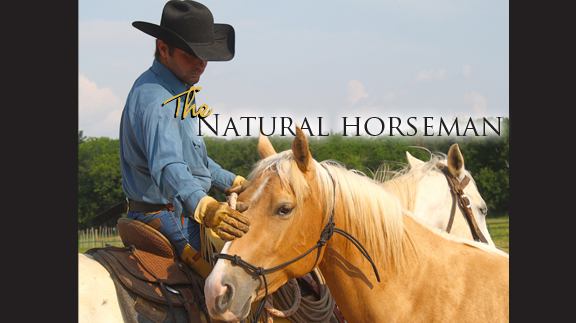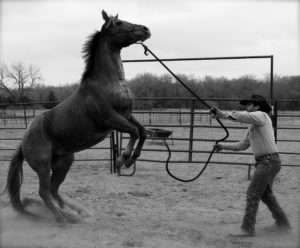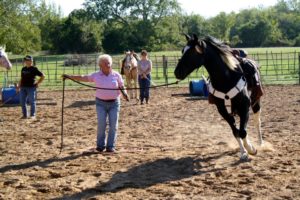HOME
Take the time it takes – The Natural Horseman

By Steve Stevens
How many minutes is your life worth? If I told you fifteen minutes of groundwork before you ride would guarantee that you would be safe from harm or injury, how many of you would do it? Well, no one can guarantee you anything in this life except that you are alive or dead. What I can do is put things very much in your favor when you ride your horse. I have heard these stories and tell me if they sound familiar. “I just don’t know what happened. He never did that before. I never saw it coming. I can’t believe he bucked with me” or “I have ridden him in parades, and then one day out on the trail, he ran off at nothing.” Over the years of working with multiple cases of these horses I have found four things. 1. The horse wasn’t trained nearly as well as the owner thought. 2. The owner’s riding level didn’t match the ability of the horse. 3. The horse was fresh and not warmed up correctly. 4. There was actually something physically wrong with the horse that the owner wasn’t aware of.

When horses are fresh, they can get overly reactive, so it is important to work this out before we ride them. (Photo by Amanda Stevens)
I want to say this in the most respectful way. I am tired of hearing about people getting hurt on horses when there was no reason for it. At the end of the day, the horse pays for this lack of attention after he hurts someone by being punished or sent down the road to another person or a sale. Sometimes the owner doesn’t want to get rid of the horse but lives in fear of the horse, and the horse is left with not much attention. I think the most important part to this is to understand that the horse is not a machine that we just turn the key and expect it to do what we want. Horses are living, breathing, thinking creatures that have emotions just like us of fear, joy and sadness. They can feel pain and they can feel healthy and strong.
They can get confident or feel insecure. They are also a prey animal that has survived a million years fleeing when it gets scared. So when anyone expects the horse to never have any of these emotions when dealing with them, they will be set up for failure, even with the brokest of broke horses. The worst wrecks are when people are riding the horse they trust the most, because they give them the benefit of the doubt. They don’t warm them up. They ask more of him than is necessary. Often they get overly confident with their horse and put them in situations they are not prepared for. Once you have had an accident or scare on your horse, please truthfully ask yourself these questions. 1. Did you do any groundwork? Most importantly, did you watch your horse walk, trot and canter quietly (the canter is the one gait that can’t be avoided) on a lunge line or in a contained area with the saddle on? 2. Do you lope your horse on a regular basis? Not just walk and trot.
If you are being truthful, I would guess that about ninety percent did not do one or both of these the day you had the accident or scare. The only reason I know this is because I get the horse after these things happened and this is nearly always the case. Why is it so important to do these things? The most basic of basic groundwork exercises is to teach your horse to lunge at all three gaits quietly. If your horse can’t do that, there is really no reason to go on. Once he can lunge quietly, this is the precursor to reading his mind, seeing how he is feeling both mentally and physically. Let’s say you practice lunging for a while to where your horse is doing it soft, quiet and consistently. Then one day you go out to work your horse and he has a rough time with the lunging. He or she is telling you something. All you need to know.
There is something that is not right. Either he is fresh and feeling his oats and needs more work to settle down, or he is bothered by something unbeknownst to the handler or he just doesn’t feel good. He could be colicky, sore or have an injury. Now that we have taken the time to figure out what is going on, what I am about to say next is the most important part. If you can’t get him back to his normal quiet self, you don’t get on. Let me say it again: you don’t get on. Most of the time the horse is just feeling fresh or has had a lack of consistent work.
It shouldn’t take long to work him through that. When you get on, he should be paying attention. If he is distracted or bothered by something and you are not an expert rider (and even then sometimes) you will have a much harder time working that out under saddle. Then there is the fact that if we don’t lunge him and watch him under saddle, how can we know how he feels physically? If you just take the time to watch your horse move he will tell you everything. If he seems sore or lame, you obviously don’t move on. You get it fixed. The second part of this is that in a contained place like an arena, you need to learn and your horse needs to learn to be cantered quietly under saddle. The canter is the third gait and the gait that holds the key to safety. A lot of people say they don’t canter because they just go on trail rides or they are scared of it.
The problem with that is that the horse knows you are scared of cantering. Truthfully, why are you scared to canter? One reason could be that you don’t have confidence in your horse and you think something bad is going to happen if you canter. Right there that should tell you something about your true feelings about your horse. Horses get broke and quiet by being cantered. If you don’t ride good enough to canter, you need to learn. If you truly want to connect and be safe with horses you need to learn to canter. I have seen children at four years old to hundred year old men learn to canter their horses. People with bad knees, people who are out of shape or people with horrible balance all can learn how to canter. If you are scared to do this, you need to find a professional to help you through this part of your journey.

The Stevens friend, Cheryl has put a lot of work in, teaching Cisco how to lunge. (Photo by Amanda Stevens)
I can’t tell you how many horrible wrecks came from people who didn’t know how to canter. The problem is that when a horse spooks at something and needs to move his feet or gets excited and wants to catch up with another horse, they generally go into the motion of the canter or run. When that happens, and you don’t canter your horse regularly, the horse and you are going to be uncomfortable. The horse will feel your tightness, which is usually what leads to him to bucking and/or running off. Please take this column entry to heart. We write this with your safety in mind. Please take the time it takes. Even if you just spend that extra fifteen minutes I offered you in the beginning, you will be amazed how much your horse experience will change.
Ride your dreams,
Steve
HOME
Preparing Spring Gardens

By Hannah Claxton | Editor
The North Texas area is located within USDA Hardiness zones seven and eight. The zones are categorized by predicted low temperatures for winter and timing of the first and last frosts.
Zone seven usually has winter low temps between 0 and 10 degrees F with the average date of the first frost falling between Oct. 29 and Nov. 15 and the average date of the last frost falling between March 22 and April 3.
Overall, these two zones have similar climates and growing conditions, making the options for timing and variety within a garden very similar.
In these zones, cool-season crops should go in the ground in March, meaning that soil preparation should start now.
To read more, pick up a copy of the January edition of North Texas Farm & Ranch magazine, available digitally and in print. To subscribe by mail, call 940-872-5922.

HOME
Equine Vaccinations

By Heather Lloyd
Vaccinations are a critical component of maintaining the health and well-being of horses, especially in environments where they are exposed to other animals, such as in the sport, show and performance arenas. Horses, like all animals, are susceptible to various infectious diseases that can spread quickly and cause serious harm.
A routine vaccination schedule helps prevent the spread of these diseases by preparing the horse’s immune system.
To read more, pick up a copy of the November edition of North Texas Farm & Ranch magazine, available digitally and in print. To subscribe by mail, call 940-872-5922.

HOME
Wichita Falls Area Cattlewomen

Having herds on a controlled breeding schedule means that we have a predictable calving schedule, and while it’s only over a couple of months, for us it does fall right after the start of the year. I lobby annually to call ours the “Winter calving season”, but I am outvoted and my husband still refers to it as Spring. Unlike producers in our Northern States, we don’t have to contend with brutally harsh winter weather, and on those rare times we do, thankfully it is not for extended periods. Regardless of whether you have a Spring or a Fall calving schedule, the health of a newborn calf begins with the mother’s health, and the mother’s health is largely dependent on the producer.
To read more, pick up a copy of the November edition of North Texas Farm & Ranch magazine, available digitally and in print. To subscribe by mail, call 940-872-5922.

-

 Country Lifestyles2 years ago
Country Lifestyles2 years agoScott & Stacey Schumacher: A Growth Mindset
-

 Country Lifestyles8 years ago
Country Lifestyles8 years agoStyle Your Profile – What your style cowboy hat says about you and new trends in 2017
-

 HOME8 years ago
HOME8 years agoGrazing North Texas – Wilman Lovegrass
-

 Outdoor10 years ago
Outdoor10 years agoButtercup or Primrose?
-

 Country Lifestyles5 years ago
Country Lifestyles5 years agoAmber Crawford, Breakaway Roper
-

 Country Lifestyles9 years ago
Country Lifestyles9 years agoJune 2016 Profile – The man behind the mic: Bob Tallman
-

 Equine1 year ago
Equine1 year agoThe Will to Win
-

 Country Lifestyles8 years ago
Country Lifestyles8 years agoDecember 2016 Profile, Rusty Riddle – The Riddle Way




